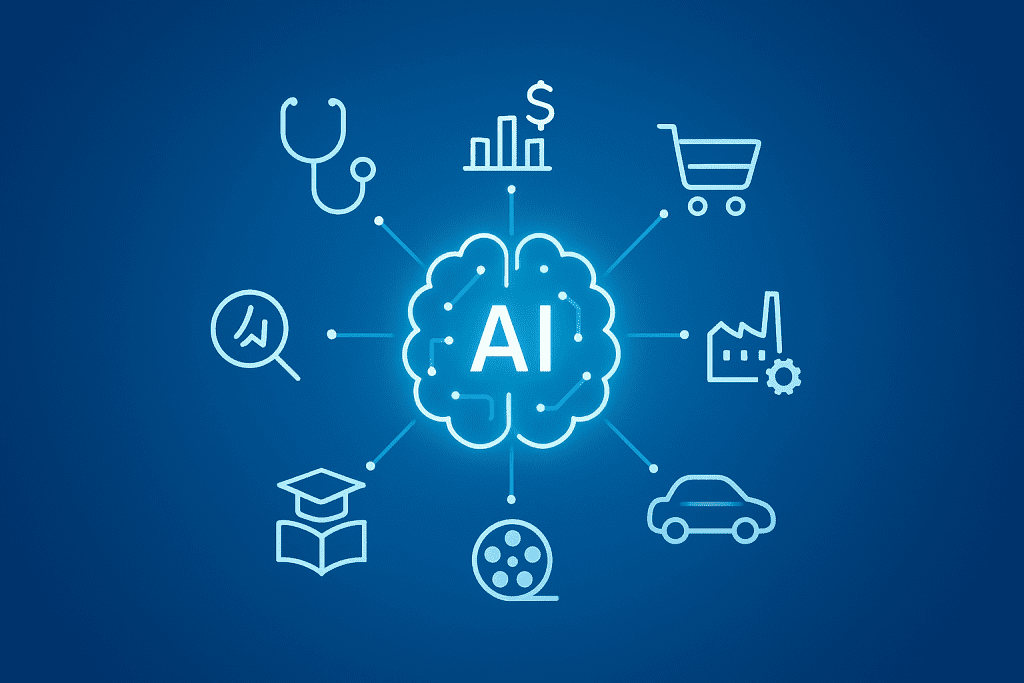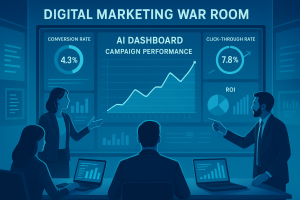
Most Uses of AI in Different Industries: A Complete Guide
AI in Healthcare
Healthcare has arguably seen some of the most impactful AI applications — improving diagnostics, accelerating drug discovery, and personalizing care.
Medical Imaging & Diagnostics
AI models (especially convolutional neural networks) analyze medical images such as X-rays, MRIs, and CT scans to detect disease markers often earlier than humans can. These models are trained on labeled datasets and can highlight suspicious regions for radiologists to review. The major benefits are faster throughput, consistent detection rates across heavy workloads, and the ability to uncover subtle patterns that may indicate early-stage disease.
Drug Discovery & Development
Traditional drug discovery can take 10–15 years. AI shrinks that timeline by predicting molecule interactions, identifying repurposing opportunities, and optimizing candidate selection. Techniques include molecular docking simulations, generative models for new compounds, and proteomics analysis. This reduces R&D costs and accelerates time-to-clinic.
Personalized Medicine
By combining genomics, EHR (Electronic Health Record) data, and lifestyle inputs, AI creates individualized treatment plans. Machine learning models find which therapies are likely to work for specific patient subgroups — increasing treatment efficacy and reducing adverse effects.
Virtual Health Assistants & Telemedicine
Chatbots and voice assistants triage symptoms, book appointments, and provide medication reminders. They reduce strain on clinics and improve access — especially in remote or resource-limited settings. Telemedicine platforms integrate AI to analyze patient-reported data and flag urgent cases.
AI in Finance
Finance uses AI for security, automation, and smarter decision-making — from retail banking to capital markets.
Fraud Detection & Risk Management
AI systems analyze transaction patterns in real time to detect anomalies signaling fraud. Methods include anomaly detection, graph analysis for relationship mapping, and ensemble models that combine multiple signals. Banks reduce chargebacks and protect customers by acting on alerts faster than manual review.
Algorithmic Trading & Portfolio Optimization
High-frequency trading firms use AI to parse alternative data (satellite images, social sentiment) and execute trades within milliseconds. Reinforcement learning and time-series models optimize strategies, while risk-aware models adjust exposure to market volatility.
Credit Scoring & Underwriting
AI improves credit decisions by incorporating non-traditional data — utility payments, mobile phone usage, and cash-flow behavior — particularly useful for underbanked populations. This expands access to credit and reduces default risk when models are well-validated and fair.
Customer Experience & Chatbots
Virtual assistants handle FAQs, assist with transactions, and surface personalized product recommendations (loans, insurance). Natural language processing (NLP) enables more human-like interactions and reduced wait times for support.
Jump to AI in Retail & E-commerce →
AI in Retail & E-commerce
In retail, AI increases conversions, improves inventory efficiency, and elevates the online — and in-store — customer experience.
Personalized Recommendations
Recommendation engines use collaborative filtering, content-based filtering, and deep learning to suggest products tailored to browsing and purchase history. Personalization increases average order value and customer retention.
Inventory & Supply Chain Forecasting
Demand forecasting models predict sales by factoring seasonality, promotions, and macroeconomic signals. Better forecasts reduce overstock, markdowns, and lost sales from stockouts.
Visual Search, AR Try-ons & In-Store Experience
Computer vision enables customers to search by image. Augmented reality (AR) allows virtual try-ons for apparel and cosmetics, reducing return rates and improving confidence in online purchases. In stores, AI can optimize product placement and queue management.
AI in Manufacturing
Manufacturing gains productivity and quality improvements through AI-driven automation and maintenance.
Predictive Maintenance
IoT sensors stream operational data to models that predict failures before they occur. Predictive maintenance lowers downtime, extends equipment life, and reduces the total cost of ownership.
Robotics & Collaborative Automation
AI-powered robots handle repetitive tasks and increasingly perform complex assembly alongside humans (cobots). Computer vision guides precision tasks, while reinforcement learning optimizes motion and throughput.
Quality Inspection
Vision systems detect defects at high speed and accuracy, enabling 100% inspection where manual sampling was once common. This reduces recalls and maintains brand trust.
Jump to AI in Transportation & Logistics →
AI in Transportation & Logistics
AI improves safety, efficiency, and cost in moving people and goods.
Autonomous Vehicles
Self-driving systems fuse sensor inputs (lidar, radar, cameras) and use deep learning to perceive and plan. While full autonomy has regulatory and technical hurdles, driver assistance systems already reduce accidents and improve highway safety.
Route Optimization & Fleet Management
Logistics platforms calculate optimal routes considering traffic, weather, and vehicle constraints. Predictive ETA models improve customer experience and reduce idle time.
Smart Traffic & Infrastructure
Cities use AI for dynamic signal timing, congestion prediction, and incident detection — all aimed at reducing commute times and emissions.
AI in Education
Education benefits from personalization, automation, and data-driven interventions.
Adaptive Learning Platforms
These platforms track student interactions and adapt content in real time — increasing engagement and ensuring students practice what they need to learn next.
Automated Grading & Feedback
AI can grade objective exams instantly and provide formative feedback on essays using rubrics and NLP. This frees educators to focus on mentorship and curriculum design.
Early Intervention & Student Support
Predictive models identify students at risk of falling behind, allowing timely tutoring or counseling. Virtual tutors assist with homework and concept reinforcement outside classroom hours.
Jump to AI in Entertainment & Media →
AI in Entertainment & Media
From content creation to distribution, AI fuels personalization and new creative possibilities.
Recommendation Engines & Personalization
Streaming platforms analyze viewing habits and engagement signals to surface relevant titles. This increases watch time and ad revenue (where applicable).
AI-assisted Creation (Music, Scripts, Visuals)
Generative models create music samples, help draft scripts, and generate visual assets. Artists use AI as a collaborator, accelerating ideation while retaining human creative control.
Audience Analytics & Marketing Optimization
Studios and publishers use AI to forecast audience interest, set release strategies, and personalize marketing campaigns across channels.
Future of AI Across Industries
What’s next? Expect wider adoption, better human-AI collaboration, and stronger regulation and ethics frameworks.
Human-Centered AI
AI will increasingly augment human capabilities. Explainable AI (XAI) and user-centric design will be priorities so humans can trust and effectively use AI tools.
Democratization & Small Business Adoption
Cloud AI services and low-code/no-code tools are bringing advanced capabilities to SMBs, enabling them to compete using intelligent automation and analytics.
Ethics, Fairness & Regulation
Regulatory frameworks will guide responsible AI: bias audits, data privacy rules, and transparency requirements. Organizations that invest early in governance will reduce legal and reputational risk.
Conclusion & Next Steps
The uses of AI across industries are broad, practical, and growing. Whether your organization is exploring pilot projects or scaling enterprise deployments, focus on: data quality, clear business objectives, cross-functional teams, and ethical guardrails.
Action items:
- Run a small pilot with clear KPIs (cost savings, accuracy improvement, time saved).
- Invest in data hygiene and instrumentation (clean, annotated, and accessible data).
- Define an AI governance policy (bias testing, privacy, explainability).
- Train staff on human-AI collaboration best practices.
If you’d like, copy this HTML into a new WordPress post (set title and slug to match) and add images using descriptive alt text such as “AI medical imaging example” or “AI predictive maintenance dashboard” for accessibility and SEO.


